How Japanese Knives Are Made
We visited the Takefu Knife Village to see how some of the most respected knife-making masters in Japan practice their craft.
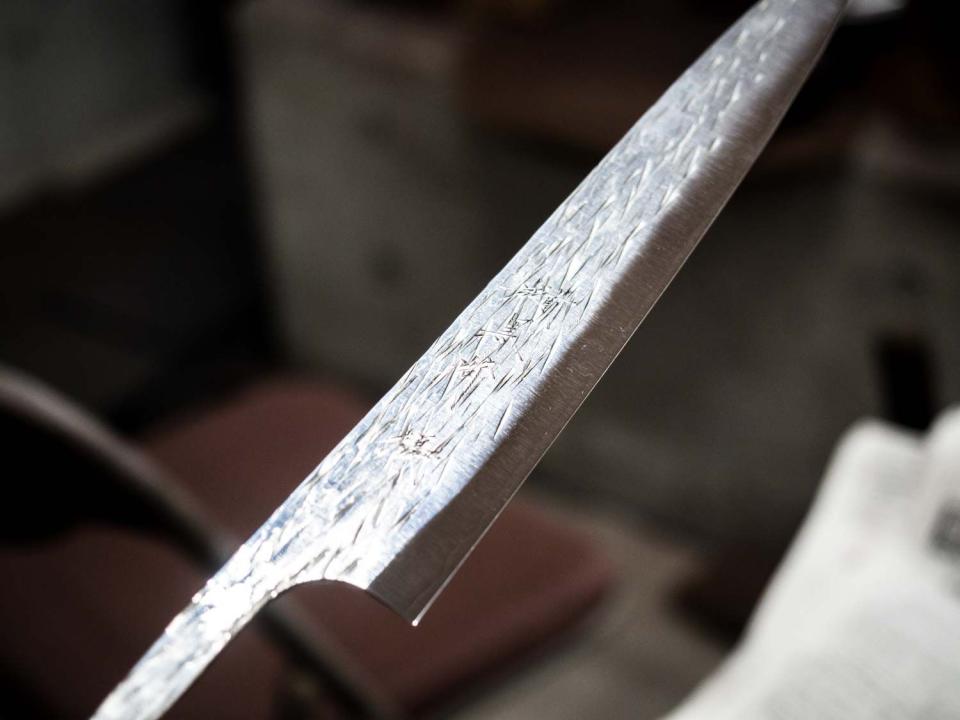
Serious Eats / Daniel Gritzer
Walk into most knife or kitchenware stores and you're likely to encounter two overarching groups: Western knives, which are rooted in German and French cutlery traditions, and Japanese knives, some of which can be traced back hundreds of years to the days of the samurai and their infamously sharp swords.
The Difference Between Japanese and Western Knives
Traditional Japanese knives come in a wide range of shapes and sizes, which are designed to perform specialized tasks, such as butchering fish and cutting vegetables, noodles, sashimi, eel, or blowfish... if cutting blowfish is something you aspire to. These knives have historically featured single-beveled blades, meaning that they're angled only on one side and are therefore right- or left-handed (usually right-handed, which is unfortunate for a lefty like me). These blades then taper into a tang that's knocked into a wooden handle.
Western knives, on the other hand, have shapes most home cooks in the US are probably familiar with (paring knives, chef's knives, bread knives, etc.), and are ambidextrous by design: the blade is sharpened symmetrically on both sides, for a double-beveled edge. Classic Western knife handles are also typically made from two pieces of wood or composite material that are used to sandwich the tang and then are secured with rivets.
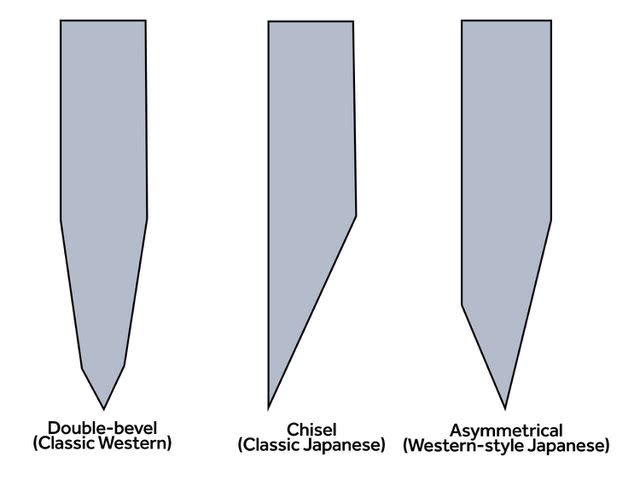
Serious Eats / Vicky Wasik
Another feature that tends to distinguish Japanese knives from Western ones is the hardness of the steel they use. Japanese knives, on average, have steel that's harder than Western ones, which makes for knives that tend to be more brittle but can also, if you're careful with them, hold their edge longer. The softer steels used in many Western knives are less brittle, so their micro-thin blade edges can roll to one side or another before they break; a rolled edge can be reset with a honing rod, something that won't work well with the more brittle, harder steel of a Japanese knife. When it comes time to touch up a Japanese blade, you'll need a whetstone.
Metal hardness is expressed as a number on the Rockwell scale, which measures how much pressure it takes to press an indentation into a material and, in the case of steel knives, is usually expressed as an HRC number. Japanese knives often have an HRC rating in the low 60s, while many Western knives have steel that’s slightly softer, with ratings in the high 50s.
These distinctions only get you so far, though, since many Japanese knife-makers go beyond traditional Japanese styles to sell a wide range of hybrid knives that blend Japanese and Western characteristics—santoku and gyuto knives are relatively commonplace examples. In some cases, Japanese companies are putting out knives that have far more in common with their Western counterparts than they do with more traditional Japanese ones. Ultimately, what we can say with certainty is that what really sets a Japanese knife apart from a Western one is that Japanese knives are made in Japan.
How Japanese Knives Are Made
But who makes those knives, and what is the process like? There are several cities in Japan that are famous for their knives, including Sakai (near Kyoto), Seki (in Gifu prefecture), and Echizen (in Fukui prefecture). To see the process firsthand, I visited a Japanese knife factory in Echizen last year. Or, more accurately, I visited eight Japanese knife factories. That's because I was at the Takefu Knife Village, a consortium of knife-makers who all work in the same facility.
Each of the eight knife-makers runs an independent business—technically, they're competitors—but they share space and some equipment, and they market their wares both independently and as a group. Plus, it seems, they're all friends. It's rare, if not virtually unheard of, to find competing businesses sharing space and resources in the US, but the knife-makers of Echizen have been making it work for centuries.
The city's history of knife-making, according to the Takefu Knife Village's website, dates back to the 14th century, when a famed blacksmith from Kyoto visited the area in search of quality water for quenching his steel. While there, he made swords, tools, and knives for the locals, teaching his trade in the process.
For many centuries, Echizen was most famed for its agricultural tools, and at one point was Japan's leading source of sickles. Though they still make farming tools, as well as scissors, production has largely shifted to kitchen knives. Today, while each manufacturer sells knives under its own name, the collective also takes knife orders from larger companies, which add their own branding to the product before bringing it to market.
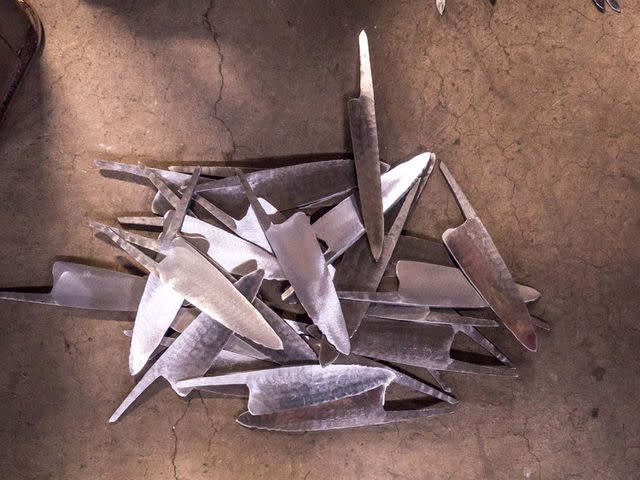
Serious Eats / Daniel Gritzer
Each knife factory at Takefu has its own house style, which is determined by the factory's master knife-maker. The masters, along with their teams of younger knife-makers, produce their lines of knives using their own preferred materials and designs, but the knives are all forged from rough blocks of steel called blanks (as opposed to being stamped from a sheet of metal, which is another common knife-making method). All the makers buy their steel from the same Takefu-based steel company, but the exact metal they choose depends on what they're making; one of their preferred ones is Super Gold 2 (or SG-2), a type of powdered steel. The knife-making process, which Yoshimi Kato, the owner of Kanehiro knives, walked me through, goes roughly like this:
Forging the Blade
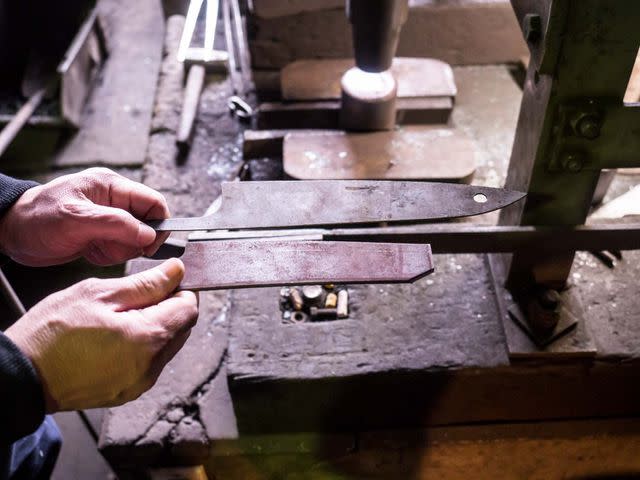
Serious Eats / Daniel Gritzer
The knife-maker starts with blanks of metal, heating them in the forge, pounding them with a power hammer—a large spring-powered rig—to begin to give them shape, and then quenching them in cold water to strengthen the metal. As this cycle is repeated, the metal gradually begins to take on the shape of the blade and the unique qualities it needs to be a good kitchen knife. Their goal, in the simplest sense, is to create blades that have a consistent hardness throughout, without any fatal flaws that could lead to trouble down the road. In some cases, the knife-maker forges together layers of different metals to combine their relative strengths and balance out their disadvantages, creating layers of cladding that are sometimes visible as a beautiful ripple of waves on the blade.
Mr. Kato told me that he often works with batches of 10 to 30 blades at a time, cycling them throughout the entire process in a three-day period.
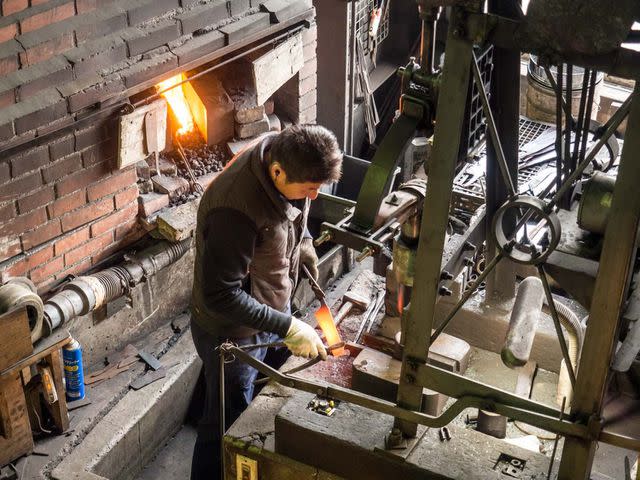
Serious Eats / Daniel Gritzer
To keep the blades nice and straight as they're forged, he will sometimes pound two at once, each knife acting as a kind of brace for the other—the thinner they grow, the more helpful this becomes.
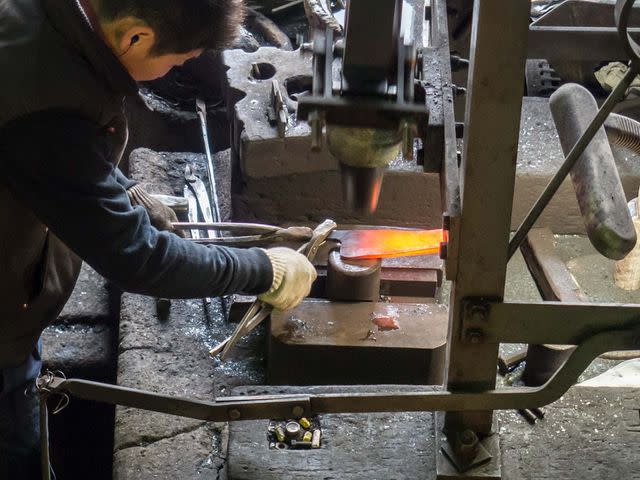
Serious Eats / Daniel Gritzer
Once the forging process is complete, the batch of knives is sent to the sanding belt, where rough edges are cleaned up.
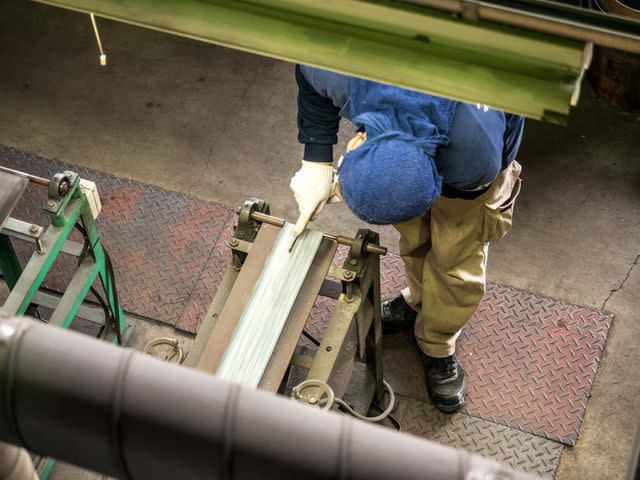
Serious Eats / Daniel Gritzer
This is especially important for knives with Western-style handles, where the tang is sandwiched between two pieces of wood (or a wood-like composite material). If the tang isn't perfectly smooth and level, there will be gaps in the handle, allowing water to penetrate and corrode it.
Kilning the Knives
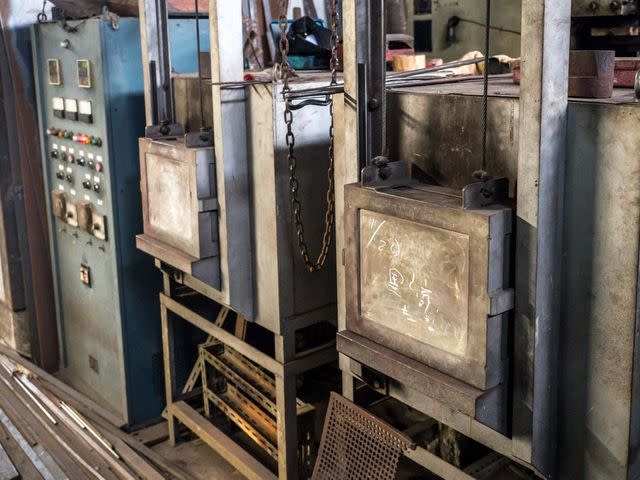
Serious Eats / Daniel Gritzer
On the second day, the knives go into the furnace to be kilned. Bringing the knives up to a high temperature and then putting them through a carefully calibrated cooling process helps control the metal's hardness by rearranging the molecular structure of the metal. But because there's still more forging to do, the metal at this point isn't brought to its final hardness level.
The kilned blades can be polished for a shiny finish, or left more or less as-is for a more rustic matte appearance. At this point, another machine is used to trim the blade, finalizing its exact shape.
Finishing the Knives
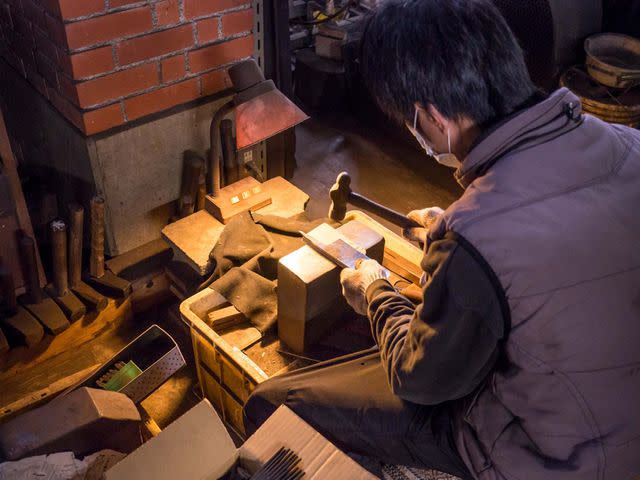
Serious Eats / Daniel Gritzer
On the third day, the blades, still in their rough shape, are pounded even more by hand, but this time without the heat of the forge—the metal, having already been kilned, is on its way to its final hardness characteristics, and putting it back into the heating and cooling cycle of the forge would throw it off.
After a final kilning, in which the blades are once again brought to a high heat and then immediately cooled in water, the metal's final hardness is set.
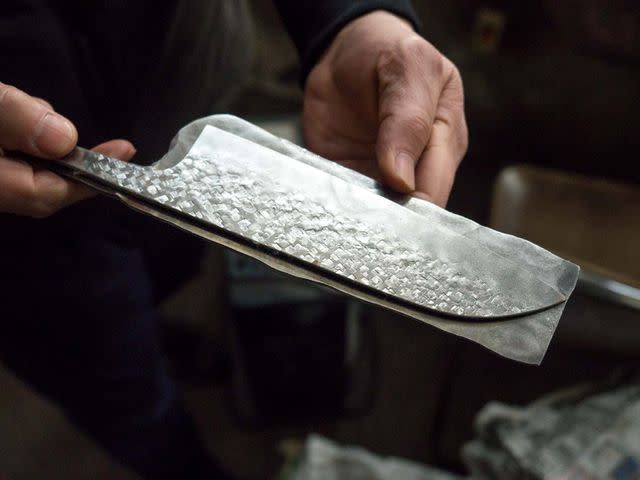
Serious Eats / Daniel Gritzer
With the knives kilned, polished, and shaped, the final steps are sharpening the blades and attaching their handles.
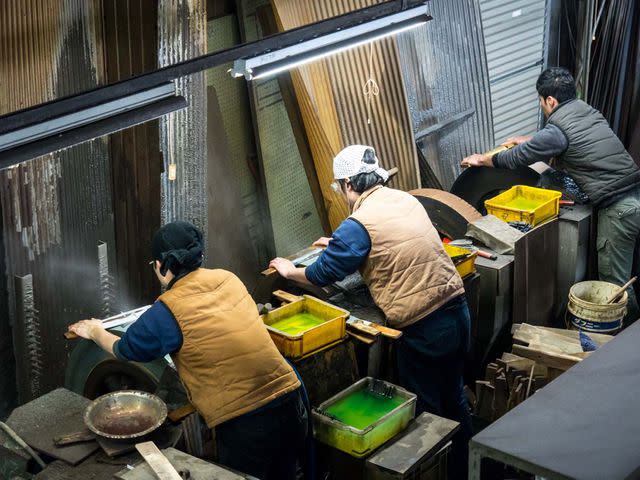
Serious Eats / Daniel Gritzer
Sharpening, of course, is no small matter, and each knife factory at Takefu has two wheels, with specialists for operating them, to put the finishing edge on its blades. Since the wheels spin at a high speed, they're sprayed with cold water to prevent the friction from raising the temperature of the metal; keeping the knife cool after kilning is of utmost importance, lest its quality be compromised.
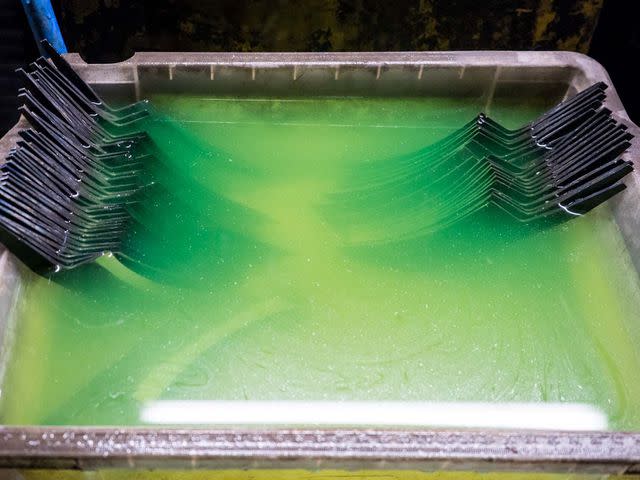
Serious Eats / Daniel Gritzer
Following my tour of the Takefu knife factory, Kato walked me across to another building in the compound where one of the knife-makers, Yu Kurosaki, makes his knives. He's the only member of the Takefu Knife Village who doesn’t work in the main building, having moved into his own once his reputation grew—at the time of my visit, he told me he was working to fulfill 3,000 orders... quite the waiting list.
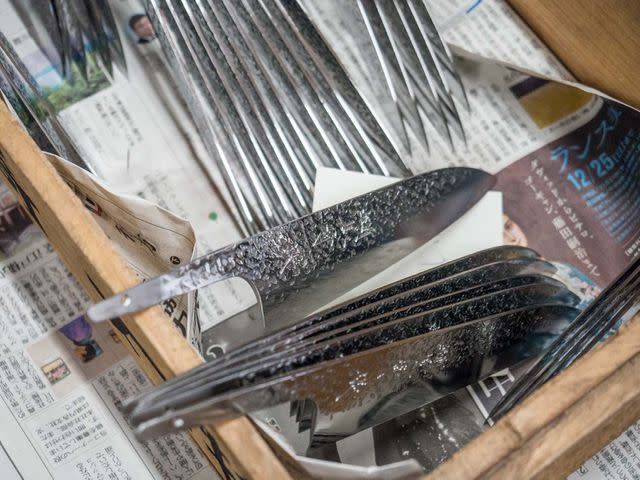
Serious Eats / Daniel Gritzer
Kurosaki's goal is to make his knives as light and thin as possible. Blades in various states of doneness sat on sandpits cut into the concrete floor, in boxes, and in tubs of anti-rusting liquid.
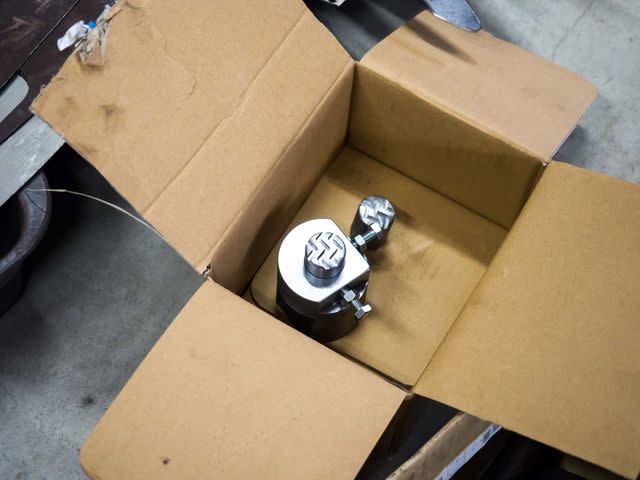
Serious Eats / Daniel Gritzer
In one box, I spotted a special metal stamp, used to impress decorative markings all over the blades.
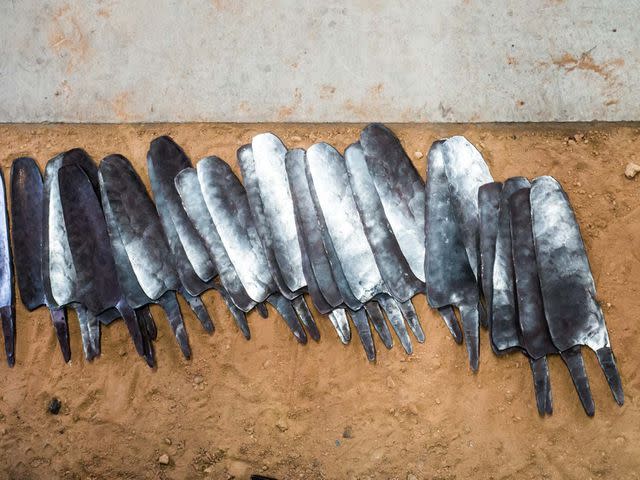
Serious Eats / Daniel Gritzer
His knives are arguably the most internationally famous ones coming out of Takefu Knife Village, but the other makers are also producing excellent blades. The only website I've been able to find that sells the knives of all the knife-makers at Takefu is Chefs Knives to Go. I've been using a couple of their knives—two santokus with traditional Japanese wooden handles, but a more Western blade-edge geometry—ever since my visit and they're definitely worth checking out.
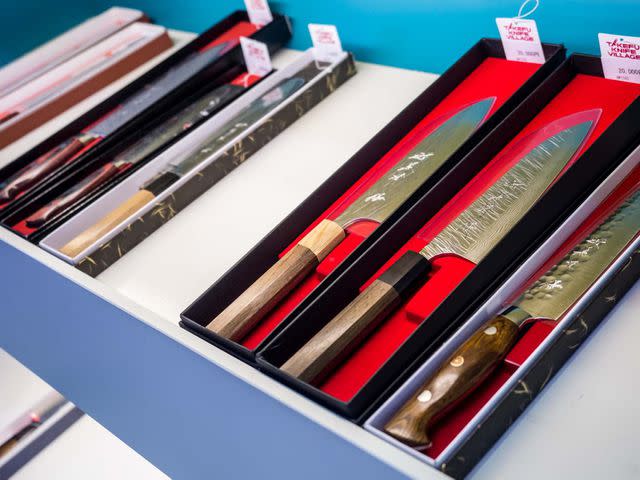
Serious Eats / Daniel Gritzer
July 2018
Read the original article on Serious Eats.

